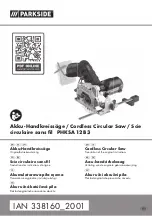
- 12 -
- that the place is not damp and is protected
from the elements.
- that there should be a large operational area
free from obstacles.
- that there is good lighting and sufficient air
exchange.
- that it needs to be used close to the general
differential switch.
- that the power supply system is earthed and
conforms to the standards (only if the electrical
tool is class 1, which is equipped with a plug
with earth cable).
- that the room temperature should be between
10° and 35° C.
- that the environment is not in a flammable/
explosive atmosphere.
- that there is a sawdust vacuum fitted with a
flexible hose.
GUIDE SET SQUARE ADJUSTMENT (pos.11)
Insert the guide set square in the guide panel
(pos.3) and tighten with the handwheel (pos.12).
Adjust the distance by observing the graduated
scale on it.
For cutting wide panels do not assemble the
guide set square but use a set square made with
a strip of wood as illustrated in fig.D.
ASSEMBLING THE CHIP VACUUM PIPE (fig.G
not supplied)
Insert the adaptor (pos. 19 fig. A) into the
chip opening (pos. 18 Fig. A) and connect the
electrical tool to a vacuum device for cutting
residuals (e.g. chip vacuum cleaner) using a
flexible hose. For the type suitable for the work,
ask your retailer.
STARTING AND STOPPING
!
!
IMPORTANT! Before starting the electrical
tool, it is compulsory to wear all the personal
protective equipment (not supplied, see the
Safety instructions).
!
!
IMPORTANT! Make sure nobody is ap-
proaching the working area while the tool is
running. Keep safety distance from all moving
parts and from the cutting area.
!
!
IMPORTANT! The motor and the blade
continue to run for a few seconds after the tool
is switched off. During this time, these parts
must not be touched. Serious injury hazard!
!
!
IMPORTANT! Never press the blade lock
button (pos.21) while the blade is moving.
Before starting the machine check the integrity
of all the components and that all the bolts and
couplings are tight.
Starting
1) Plug the tool into the power supply (pos.8).
2) Grip the rear hand grip (pos.5) and the front
hand grip (pos.4) firmly without pressing the
switch (fig.C).
3) Press the safety button (pos.7) and the switch
button (pos.6) in sequence. The switch is a
‘maintained action’ switch so the electrical tool
will stay on when you keep the switch pressed.
Stopping
To stop release the switch button (pos.6) holding
the machine firmly.
We recommend repeating these operations
several times before starting work, in order to
familiarise yourself with the controls as far as
possible.
If you notice any working defects, switch off
the electrical tool and consult the chapter “Pro-
blems, causes and solutions”.
When not using the tool, turn it off and discon-
nect the plug from the socket.
USER INSTRUCTIONS
!
!
IMPORTANT! Before carrying out the fol-
lowing operations, make sure that the plug is
disconnected from the mains.
After reading the previous chapters carefully,
apply these tips scrupulously to obtain maximum
performance.
Proceed calmly so as to become familiar with
all the controls; after having gained sufficient
experience you will be able to make full use of
its potential.
ADJUSTING THE CUTTING DEPTH
This is obtained by varying the amount the blade
sticks out in relation to the guide panel.
Loosen the cutting height adjustment handwheel
(pos.17) and move the guide panel (pos.3)
downwards in order to reduce the cutting depth,
and upwards to increase it. Fix the handwheel
well after adjusting the guide panel in the desired
position.


































